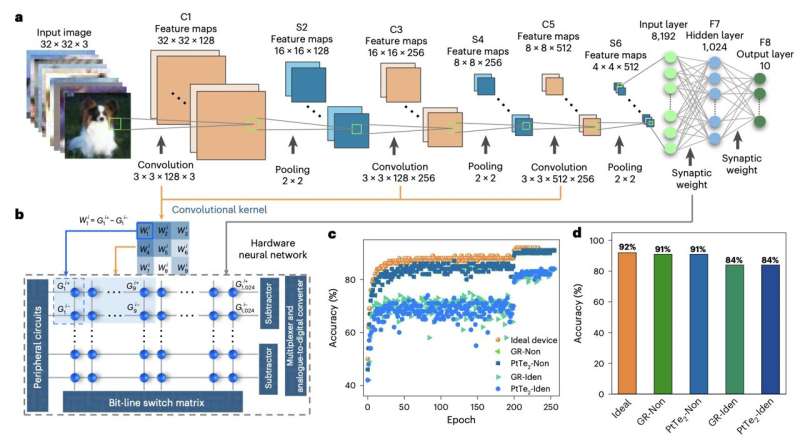
November 7, 2024 by Ingrid Fadelli , Tech Xplore
Collected at: https://techxplore.com/news/2024-11-unique-memristor-analog-high-efficiency.html
The growing use of artificial intelligence (AI)-based models is placing greater demands on the electronics industry, as many of these models require significant storage space and computational power. Engineers worldwide have thus been trying to develop neuromorphic computing systems that could help meet these demands, many of which are based on memristors.
Memristors are electronic components that regulate the flow of electrical current in circuits while also “remembering” the amount of electrical charge that previously passed through them. These components could replicate the function of biological synapses in the human brain, thus improving the efficiency with which machine learning-based models analyze data and perform computations.
Despite their potential, most memristors developed to date have exhibited significant limitations, including small on/off ratios. These small ratios hinder the ability of the memristors to represent precise weights, thus increasing noise and reducing the accuracy of an algorithm’s predictions.
Researchers at Wuhan University recently developed promising new memristors with analog switching and high on/off ratios. These memristors, introduced in a paper published in Nature Electronics, were fabricated using two-dimensional (2D) van der Waals metallic materials as cathodes.
“Analog memristors with multiple conductance states are of particular use in high-efficiency neuromorphic computing, but their weight mapping capabilities are typically limited by small on/off ratios,” Yesheng Li, Yao Xiaong and their colleagues wrote in their paper.
“We show that memristors with analog resistive switching and large on/off ratios can be created using two-dimensional van der Waals metallic materials (graphene or platinum ditelluride) as the cathodes. The memristors use silver as the top anode and indium phosphorus sulfide as the switching medium.”
The unique memristor design proposed by Li, Xiaong and their colleagues introduces a extra high diffusion barrier that limits the migration of silver ions. This ultimately enables analog switching, as well as on/off ratios comparable to those reported in digital memristors.
“Previous approaches have focused on modulating ion motion using changes to the resistive switching layer or anode, which can lower the on/off ratios,” wrote Li, Xiaong and their colleagues.
“In contrast, our approach relies on the van der Waals cathode, which allows silver ion intercalation/de-intercalation, creating a high diffusion barrier to modulate ion motion. The strategy can achieve analog resistive switching with an on/off ratio up to 108, over 8-bit conductance states and attojoule-level power consumption.”
To evaluate their memristors, the researchers performed a chip-level simulation of a convolutional neural network (CNN) for image recognition. Their findings were highly promising, as in this simulation, the model performed remarkably well, achieving high image recognition accuracies of up to 91%.
In the future, the team’s newly developed memristor could be improved further and used to run other advanced AI-based computational models. In addition, other researchers could set out to develop similar memristors using alternative materials as the switching medium or other van der Waals materials as cathodes.
More information: Yesheng Li et al, Memristors with analogue switching and high on/off ratios using a van der Waals metallic cathode, Nature Electronics (2024). DOI: 10.1038/s41928-024-01269-y
Journal information: Nature Electronics

Leave a Reply